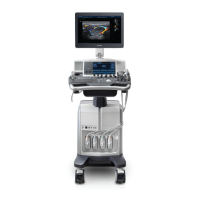15-4 Acoustic Output
Controls that indirectly control output
Controls that are receiver controls
Direct controls
It is possible to control, if necessary, the acoustic output with the ―A.power‖ item on the touch
screen or the corresponding knob at the bottom of touch screen. In this case, the maximum
value of the acoustic output never exceeds an MI of 1.9 and an I
SPTA.3
of 720 mW/cm
2
in any
mode of operation.
Indirect controls
The controls that indirectly affect output are the many imaging parameters. These are
operating modes, frequency, focal point positions, overall depth, and PRF.
The operating mode determines whether the ultrasound beam is scanning or non-scanning.
Thermal bioeffect is closely connected to M mode, Doppler and Color mode. Acoustic
attenuation of tissue is directly related to probe frequency. The focal point is related to active
aperture of probe and beam width. For the higher PRF (pulse repetition frequency), the more
output pulses occur over a period of time.
Receiver controls
The receiver controls (for example, gain, dynamic range, and image post-processing, etc.)
won’t affect output. These controls should be used, when possible, to improve the image
quality before using controls that directly or indirectly affect output.
15.7 Acoustic Output
15.7.1 Derated Ultrasonic Output Parameters
In order to determine the relevant Ultrasonic Output Parameters, a method is used which allows
for the comparison of ultrasound systems which operate at different frequencies and are focused
at different depths. This approach, called ―derating‖ or ―attenuating‖, adjusts the acoustic output as
measured in a water tank to account for the effect of ultrasound propagation through tissue. By
convention, a specific average intensity attenuation value is used, which corresponds to a loss of
0.3 dB/cm/MHz. That is, the intensity of ultrasound will be reduced by 0.3 dB/MHz for every
centimeter of travel from the probe. This can be expressed by the following equation:
)10/3.0(
10
zf
wateratten
c
II
-
Where I
atten
is the attenuated intensity, I
water
is the intensity measured in a water tank (at distance z),
fc is the center frequency of the ultrasound wave (as measured in water), and z is the distance
from the probe. The equation for attenuating pressure values is similar except that the attenuation
coefficient is 0.15 dB/cm/MHz, or one-half the intensity coefficient. The intensity coefficient is
double the pressure coefficient because intensity is proportional to the square of pressure.
Although the attenuation coefficient chosen, 0.3 dB/cm/MHz, is significantly lower than any specific
solid tissue in the body, this value was chosen to account for fetal examinations. In early trimester
ultrasound fetal examinations, there may be a significant fluid path between the probe and the
fetus, and the attenuation of fluid is very small. Therefore the attenuation coefficient was lowered
to account for this case.
15.7.2 Limits of Acoustic Output
In accordance with the FDA Track 3 requirements, the derating (or attenuated) approach was
incorporated into the FDA Acoustic Output Limits, as listed below. The maximum acoustic output
level from any probe in any operating mode is expected to fall below these limits.

